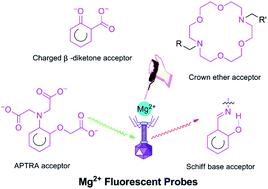Fluorescent probes for the detection of magnesium ions (Mg2+): from design to application
Abstract
Magnesium ions (Mg2+) play essential roles in various physiological and pathological processes, its abnormal homeostasis in cells is related to many diseases, such as diabetes, neuromuscular disorders, hypertension and other cardiovascular disorders. Investigation on the regulation of magnesium in cellular processes has attracted considerable interest in the past several decades. Among those reported strategies, fluorescent imaging technology has become a powerful and cost-effective tool for the real-time monitoring of magnesium distribution, uptake and trafficking, due to its superior features of high sensitivity and non-invasiveness, as well as excellent spatial and temporal fidelity. Herein, we critically summarize the progresses in the intracellular magnesium detection with fluorescent imaging probes. Our discussion focuses on the recent contributions concerning fluorescent imaging probes for mapping magnesium in biological processes. All the candidates are organized according to their acceptor structures. The sensing mechanisms of fluorescent probes are also highly taken into account. Challenges, trends and prospects of fluorescent imaging technology in magnesium detection are also set forth.



 Please wait while we load your content...
Please wait while we load your content...